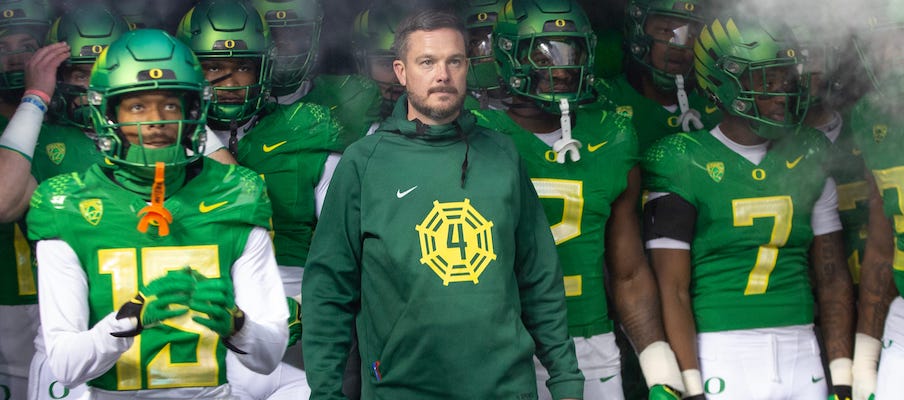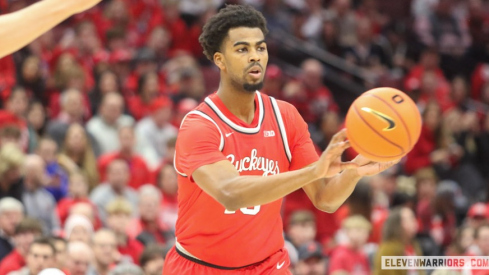Former North Carolina defensive end Beau Atkinson commits to Ohio State.
This season’s national champion will be playing in the Big Ten next season.
That statement will be true no matter who wins Monday night’s College Football Playoff final. While Washington will be representing the Pac-12 one last time in the national championship game, the Huskies will officially become Big Ten members in August. They’ll join a conference that has always included Michigan, the other team playing for college football’s top prize Monday night in Houston (7:30 p.m., ESPN).
As the Big Ten prepares to welcome four new members later this year, it couldn’t ask for better marketing than what it’s going to get from one of its current members going head-to-head with one of its incoming members on college football’s biggest stage.
For fans of Ohio State and other Big Ten schools, Monday night will serve as a preview of just how big of a challenge it could be to win the conference championship going forward.
In recent years, the battle to win the Big Ten has often felt like just a two- or three-team race. Michigan has been the dominant team of late, winning the last three conference championships, though Ohio State was in the thick of the race until it lost the season-ending rivalry game each year. Ohio State was the conference’s dominant power before that, winning four straight Big Ten titles from 2017-20, losing only two total Big Ten games between those four seasons.
As the Big Ten prepares to move to a divisionless format in 2024, that recent history has sparked concerns that The Game could become less significant due to the likelihood that Ohio State and Michigan could end up playing each other in back-to-back weeks. But while it’s likely inevitable that scenario will play out at some point, Washington’s 14-0 run to the national championship game is just one piece of evidence that Ohio State and Michigan will have far more competition to worry about than just each other going forward.
Add in No. 2 Washington and No. 8 Oregon with No. 1 Michigan, No. 6 Ohio State and No. 10 Penn State, and teams who will be in the Big Ten next year made up five of the top 10 spots in this year’s final CFP rankings. (The other four spots were occupied by teams that will be in the SEC next year; the only other team in the top 10, Florida State, has openly talked about leaving the ACC, which could potentially mean joining the Big Ten in the future.)
| Rank | Team | 2024 Conference |
|---|---|---|
| 1 | Michigan | Big Ten |
| 2 | Washington | Big Ten |
| 3 | Texas | SEC |
| 4 | Alabama | SEC |
| 5 | Florida State | ACC |
| 6 | Georgia | SEC |
| 7 | Ohio State | Big Ten |
| 8 | Oregon | Big Ten |
| 9 | Missouri | SEC |
| 10 | Penn State | Big Ten |
| 11 | Mississippi | SEC |
| 12 | Oklahoma | SEC |
| 13 | LSU | SEC |
| 14 | Arizona | Big 12 |
| 15 | Louisville | ACC |
| 16 | Notre Dame | Independent |
| 17 | Iowa | Big Ten |
| 18 | NC State | ACC |
| 19 | Oregon State | Pac-12* |
| 20 | Oklahoma State | Big 12 |
| 21 | Tennessee | SEC |
| 22 | Clemson | ACC |
| 23 | Liberty | Conference USA |
| 24 | SMU | ACC |
| 25 | Kansas State | Big 12 |
| *Oregon State and Washington State remain in the Pac-12 despite the departure of the rest of its members | ||
Oregon, Washington and USC – who is coming off a disappointing 8-5 season but still has the talent to make noise in the Big Ten as soon as next year – all project to be bigger threats to Michigan and Ohio State’s dominance of the conference than anyone other than Penn State has been recently. Even UCLA, which is coming off of back-to-back eight-win seasons, has the resources to elevate the conference’s overall level of play even if it is unlikely to be a serious Big Ten title contender in the near term.
The good news for Ohio State, Michigan and Penn State is that they’ll now be competing for two spots in the Big Ten Championship Game instead of just one (now that the Big Ten’s East and West divisions are no more). But that won’t necessarily make their respective paths to the conference championship game any easier because of the additional competition that’s entering the conference.
Winning the Big Ten Championship Game will be as important as ever under the new College Football Playoff structure, as the top four seeds and corresponding first-round byes will be only available to conference champions. That said, the addition of more competition to the conference is certainly made more palatable to the Big Ten’s existing members by the playoff’s expansion to 12 teams, which should ensure that multiple Big Ten teams make the CFP every year.
Neither Michigan nor Washington is expected to be as elite next season as they are this season. The Wolverines have a senior-heavy starting lineup, which means they’ll have to replace a lot of key players after Monday’s game, though some of those seniors could still return for an extra year of eligibility. The Huskies are losing star quarterback Michael Penix Jr. and their 2024 recruiting class ranks just 36th in 247Sports’ composite rankings.
Still, neither team can be overlooked as a contender to win the Big Ten next season based on what it’s accomplished this season – or in Michigan’s case, the past three seasons. Oregon will also enter the conference as a major contender to win the Big Ten right away; while the Ducks are losing their own Heisman finalist quarterback in Bo Nix, they replaced him with two of the top quarterbacks in this year’s transfer market (Dillon Gabriel and Dante Moore) and will rival Ohio State for the most talented roster in the Big Ten entering the 2024 season.

Just to make it to Indianapolis next season, Ohio State will have to successfully navigate a conference schedule that includes road trips to Oregon and Penn State before the regular season culminates with a home game against Michigan. The Buckeyes can count on having at least three difficult conference games each year going forward; Ohio State’s 2025 Big Ten schedule is set to include road games against Michigan and Washington and a home game against Penn State, while Ohio State is set to play all three of Michigan, Oregon and USC in both 2026 and 2027.
Unlike this year, Ohio State won’t need to go undefeated to ensure it makes the CFP going forward; the Buckeyes will likely make the 12-team CFP any time they go 10-2 or better in the regular season, and there may be some seasons where they can even make it at 9-3. But OSU won’t be able to simply cruise to the playoff each year with an influx of new Big Ten members who will expect to be regular CFP contenders themselves.


